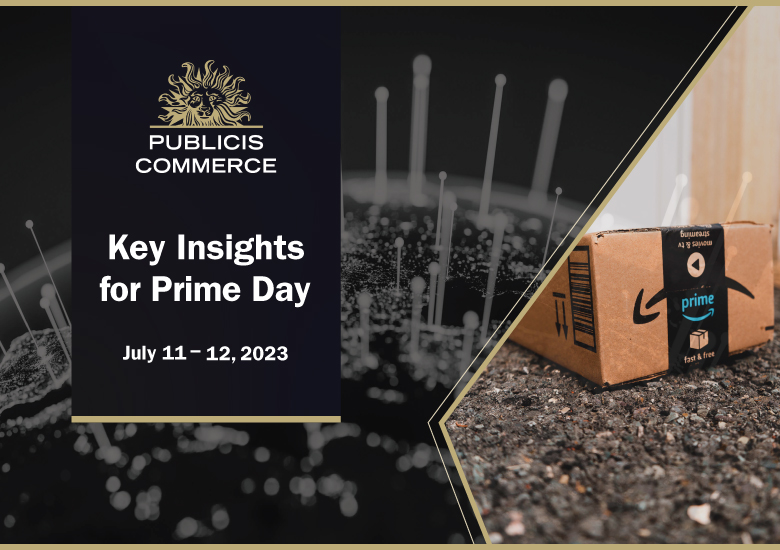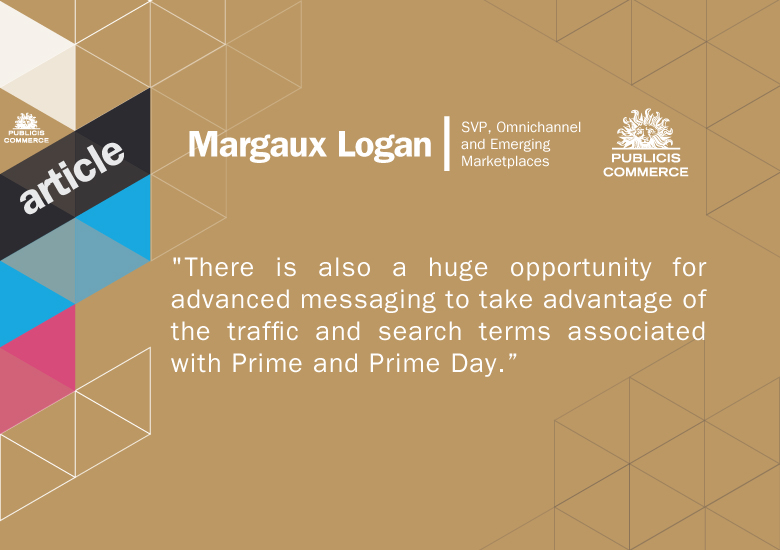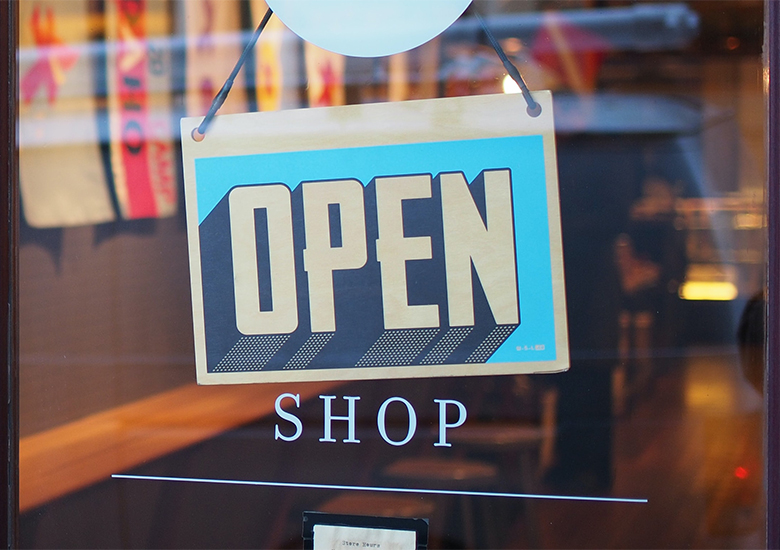How Prime Day Lifts Online and In-store Revenue for Retailers Who Know How to Leverage It.
Prime the Day
Often referred to as ‘Summer Black Friday,’ Amazon Prime Day is the annual, two-day sale event on Amazon.com. Typically, a summer event – but with a Fall event in 2020 and an expected Fall event in 2022 to come – Prime customers have opportunities to save on big-ticket items and everyday household purchases, including groceries. Despite nearly 170M estimated US-based Prime members already, for those who want to take part in the savings, Amazon offers a 30-day free trial that grants full access to all the deals.
But Prime Day isn’t only about two days of deals; unique shopping experiences and savings start more than three weeks before the sale. The lead-up to the actual event is full of anticipation on the exact timing, messaging and leveled up search budgets for key products to ensure essential placement on SERPs. This year there had been some hiccups with brands putting money behind Lightning Deals pre-Prime day. These deals offer a limited number of discounts for a short period of time, however, as shoppers presume the best deals are claimed on Prime Day proper, these early bird brands missed out on critical sales.
Alternative channels were also a factor this past Prime Day. Brands took to social, email and their own DTC channels to push their upcoming Amazon deals. In the past, brands feared this would cannibalize sales; however, this sentiment is changing with tools like Amazon Attribution to support brands in understanding which alternative channels are most effective in driving sales to their Amazon product listings.
Membership Has Its Privileges
Amazon is acutely aware that in order to keep its millions of members engaged, it must continue to evolve its Prime membership benefits — all the while attracting and retaining new members as well as staving off the stiff competition from Walmart+ and other retailer offerings.
Beyond Prime Day deals, Amazon offers a plethora of benefits, including 2-day shipping, video and music streaming, photo storage, and several other key benefits. In order to spread awareness of their full benefits offering, this year, Amazon set up a scavenger hunt type campaign where members were awarded a $10 credit for completing a set of four tasks which included: Making a Prime-eligible purchase, watching a show on Prime Video, streaming a song on Prime Music and borrowing a book on Prime Reading.
As for introducing new member perks, Amazon recently announced a timely PR push one-week pre–Prime Day, a newly minted partnership with GrubHub, offering members free Grubhub+, which eighty-sixes food delivery fees. Amazon attempted to enter the restaurant delivery space in the past with Amazon Restaurants which shut down in 2019. However, this new partnership shows that Amazon is willing to learn from leaders in their respective fields and gain valuable information on how and who uses these types of services.
Get Fresh
What does the #1 eRetailer do once they’ve dominated digital shopping with a single event? Use that sale to drive growth in other channels. 2017’s acquisition of Whole Foods marked Amazon’s first venture into established brick and mortar. The most noticeable and immediate impact of the purchase: the unmistakable round, blue stickers that granted Prime members deep discounts on weekly specials. Whole Foods now fully participates in Prime Day, offering members even deeper discounts and is another channel for Amazon to drive Prime Day profits.
This year, Amazon Fresh is being added to the mix of Prime Day events with a push on in-store savings and undoubtedly getting more shoppers to try shopping at Fresh. Beyond driving in-store traffic, the model also extends to brand partnerships with an in-store element to the sales process. For example, Budget Car Rentals’ Prime Day deal gets members 30% off rentals and 20% cash back in the form of an Amazon gift card. It’s a clever model that allows Budget to cash in on the branding and excitement of Prime Day and drives growth back to Amazon sales. Rewards and offers like this have limitless growth potential for Amazon while giving brands a recognizable benefit and cache for their customers.
Don’t Forget About Me
Competitive retail marketplaces like Target and Walmart have leveraged Prime Day to increase their bottom lines for years. By launching 'anti-prime' sales that fall on Prime Day, often with campaign names that play on the concept of Amazon's famous shopping sale, competitors are cashing in on shoppers that are 'primed' to spend. In 2021, 26% of Prime Day shoppers online comparison-shopped at Walmart, and 21% did the same at Target. In 2022 we saw a wide selection of sales across multiple retailers again, capitalizing on consumers being in the shopping and searching mood.
As the success of Prime Day-like sales continues to bring in Black Friday-like revenue growth, direct-to-consumer brands are also getting in on the action. A great example is Bala, a DTC fitness brand that increased sales by 187% during Prime Day 2021. While using their social and CRM channels to promote their Amazon-site deals, DTC brands also promote deep discounts on a selection of items listed on their own site. This way, Amazon's advertising activations are doing the heavy media lifting, and brands are taking full advantage of the Prime Day name. In addition to this, the availability of "Buy with Prime," which launched in April 2022, allows DTC sites to offer their consumers the seamless benefits of an Amazon checkout process. Fast shipping using Amazon’s payment and checkout process is traded for data and a fee for fulfillment by Amazon. Overall, Buy with Prime makes a seamless and easy fulfillment model democratic.
Seeing Double
Following Amazon's lead in grocery, other retailers realize that Prime Day and their own associated sale days are not just about digital. Brands and retailers that make most of their revenue in brick-and-mortar are increasing online advertising around Prime Day and are implementing tactics to drive online shoppers to pick up in-store.
This year, Target's Deal Days sale pauses the shopping cart experience by teasing a 2-hour in-store pick-up versus waiting the 2-5 days it takes their item to ship. Target also offered shoppers a 10% discount off their total order for any in-store purchases during Deal Days. In addition to providing convenient consumer options and saving on logistic costs, retailers know that driving online shoppers to their physical locations will score them additional shopper dollars. 85% of consumers who use Buy Online Pickup In Store (BOPIS) say that they have made other unplanned purchases when picking up. It's a win-win tactic for retailers with a physical and digital presence.
So, What Happened?
Results are still coming in as of July 18th, but we know Prime members purchased more than 300 million items (more than 100,000 items per minute) worldwide, making this year’s event the biggest in Prime Day’s 7-year history. In the US alone, this meant 60K items PER MINUTE. The key categories were consumer electronics (a perennial winner), home (a consistent theme during these pandemic years) and household essentials. The latter, which is not typically a winning category, indicates that inflation is not scaring consumers away from spending but is making them look for the right deals in categories that are not as exciting but essential. Amazon will need to make up for those low-margin items somewhere, but they’ve certainly swiped sales in these areas from Walmart and Target for the next few months.
Interestingly, consumer sentiment was not overly impressed with Prime Day. There was a general feeling that the deals weren't as good, as exciting or just remarkably similar to Prime Days past. However, prices were 3% lower on average than Prime Day 2021 and products that showed a direct comparison in the days leading up to Prime Day had an average 18% price drop!
Amazon also spent a lot of time and effort on Amazon Live, influencers and TikTok tie-ins with cult products were sectioned off in-app. Andrew Pearl of Profitero noted "Influencer sold deals, from a sample that we reviewed, on average saw a 938% rise in sales rank…however when the Amazon Live feature was added to a Prime Day discount, this average uplift grew a further 2.5x." The app was much more clearly laid out with deals and category spotlight ads this year, but the same search issues persisted where users were far too easily exited off of Prime Day Deals when reviewing product pages. No matter, however, as right now the anticipated results are a besting of the 2021 11.8B in sales.
For tips on how to leverage Prime Day – check out our take on Priming for Prime Day here.
Sources:
https://www.forbes.com/sites/stevebanker/2019/06/25/how-amazon-changed-whole-foods/?sh=4e09a2678dda
https://ftnnews.com/retail/44215-amazon-announces-date-of-prime-day-2022
https://retailwire.com/discussion/did-amazon-or-a-rival-say-target-gain-the-most-from-prime-day/
https://mutesix.com/how-and-why-dtc-brands-should-leverage-prime-day-2022/

















